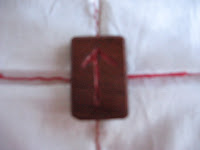Recently I have acquired two older books dealing with Runes, seeming classics (in a sense) written by Nigel Pennick, Practical Magic of the Northern Tradition and Runic Astrology. The main focus of Runic Astrology, and one of the major chapters of Practical Magic, is Time, Planets, and Stars and how they related to the Runes, particularly the Elder Futhark. By time, I mean, hours of the day, parts of day and night (morning, evening etc…) months, seasons, lunar movement, and the solar year. By planets, I mean the seven classic planets (Saturn, Jupiter, Mars, Sun, Venus, Mercury, and the Moon) and the stars are the Zodiac, but also other stars and constellations.
To be perfectly honest, my hope and expectations for the book Runic Astrology, were much higher then it delivered. The reason why I acquired this book, was mainly because of a great interest I have had in Astrology, and it’s processes, purposes and methods. This led me to read “The Three Books of Occult Philosophy” by Cornelius Agrippa, one of the foundational books of Western Occultism. It has also made me a major fan of the website “Renaissance Astrology” and Christopher Warnock, who is focused on the methods of Astrology before 1700, when Astrology essentially ruled the World (so to speak) and was a valued science by every scholar and philosopher of the time. The depth of knowledge that I have gained just from reading and studying his website, and following his blog has been wonderful, and some of the information that I have applied in understanding my own natal chart has shown great veracity, far more then any contemporary astrology practices have. With this foundation, I dove into Runic Astrology, hoping to find a way to connect the runes to astrology, the planets, the zodiac and tools and methods of astrological prediction and magic. I have to say, I was rather disappointed.
One of the main things that were talked about at length was the connection of Runes to parts and hours of the day, directions and seasons, solstices and equinoxes. This was all connected to a circular image, where those connections were laid down, with the elder futhark drawing the connection between them. It seemed the key to the diagram was the location of the rune dagaz, giving it to noon (or midday), which also connected it to the south, and the summer solstice. While it does seem correct in that placement (dagaz meaning day, and is thus a rune of light) that puts, in opposition to it, jera, the rune of harvest, the summer, the year, and of plenty, located at midnight, north, winter solstice, which seems a very odd location to put a rune that is also filled with powerful benevolent imagery.
Other things were also equally inexplicable, for example, in giving runic hours (24 runes = 24 hours makes sense, right) governed by an equal division, based on the half hour of the clock. So, feoh is in operation from 1:30 to 2:30 pm. This seems odd to me, as it stands distinctly from the planetary hours, which are divided by time of daylight, and are not an even 60 minutes long, but have varying lengths depending upon the duration of day and night during the year. Why an equal division is necessary seems curious to me, and then placing it on the half hour, it seems to just make things unnecessary difficult.
One of the other functions of time that he looked at, is what was called the lunar seles. The seles would otherwise be known as the mansions of the moon. In contrast to Western practice, the book only gives 28 mansions (which is following Vedic astrology), while Agrippa (from Arabic methods) gives 29 mansions of the moon. In giving those 28 mansions, he assigns them runes from the elder futhark and the anglo-saxon runes, leaving out one rune, because there are normally 29 of them. But when the western tradition uses 29 mansions, one could use all of those runes, in placement with all of the mansions. The question is then to how to place the runes in the lunar mansions. While Pennick ignores the existing traditions of the lunar mansions, his allocation gives the first rune (feoh) to the first mansion (ie the first day following the dark moon) and going forward until the last rune (ear) given to the dark moon. While the last rune may fit well, the allocation of other runes doesn’t seem quite so correct, as the full moon would correspond with peorth, which does not seem quite so perfect an alignment. At least, if the traditions of the lunar mansions were applied, the full moon would fall in different runes all the time, as would the dark moon, and give different aspects and purposes to different times, instead of always assigning the same values to the phases of the moon.
The final oddity of his time values is the runic half month. Because there are 24 runes, the regular year gets divided into approximately 2 periods of 15 days each, where one rune governs that time period. They aren’t necessarily aligned with anything, not the zodiac, not the months, or anything, but just this cycle, following along with dagaz governing the 15 day period where the summer solstice occurs and jera happening when the winter solstice occurs. It doesn’t really seem to fit into any type of time keeping, but is something established all on its own, which also doesn’t have any historical basis, or alignment with symbolism of anything else.
Part 2 will focus on Planets.







































